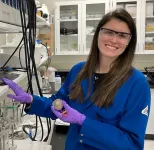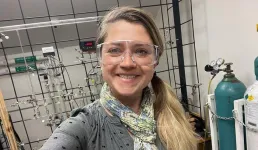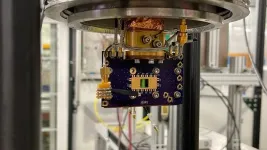(Press-News.org) Biomedical engineers at Duke University have demonstrated a new synthetic approach that turbocharges bacteria into producing more of a specific protein, even proteins that would normally destroy them, such as antibiotics.
The technique directs bacteria to produce synthetic disordered proteins that bunch together to form compartments called biological condensates. When these compartments trap mRNA carrying instructions for specific proteins together with the machinery needed to implement them, they can greatly enhance the rate of protein production.
The technique could be a boon to industries that use bacteria to produce a wide range of products such as pharmaceuticals, industrial chemicals and biofuels.
The results appeared online February 10 in the journal Nature Chemistry.
Biological condensates are useful tools that are already abundant in nature. All cells use condensates to trap together or separate biomolecular machinery to dial its activity up and down. Since the phenomenon was discovered in 2009, their uses and functions have been a topic of vigorous study.
“Condensates are useful for cells to temporarily control gene expression in response to new conditions or challenges because, by quickly controlling gene expression at the protein production level, rather than at the DNA level, they can make changes in which proteins are produced in minutes instead hours or even days.” said Daniel Shapiro, a PhD student working in the laboratory of Ashutosh Chilkoti, the Alan L. Kaganov Distinguished Professor of Biomedical Engineering at Duke. “But naturally occurring condensates are extremely complicated and difficult to engineer. Our lab is one of the few directing cells to make synthetic versions that can be specifically tailored to fit our purposes.”
The Chilkoti Laboratory specializes in elastin-like polypeptides, or ELPs for short. These long, disordered proteins are like globs of noodles that can be tailored to clump together or dissolve apart based on a wide range of variables such as temperature or acidity.
In 2023, the laboratory was the first to show that bacteria could be programmed to make these synthetic disordered proteins and have them form condensates that affect biological machinery.
“That work showed that we, as biomedical engineers, could design new molecular parts from the ground up, convince cells to make them, and assemble these parts inside the cell to make a new machine,” Chilkoti said. “It was the beginnings of an emerging field that is now allowing us to reprogram life in new and exciting ways.”
That research, among other results, showed that synthetic biological condensates could trap together biomolecular machinery to speed up their work. But it did not seek to specifically instruct the cell which processes to speed up or which proteins to produce.
This new work builds on that base to do exactly that. The researchers instructed bacteria cells to produce ELPs that form condensates and also bind to specific RNA sequences, which copy and carry the blueprints for building proteins from DNA to the rest of the cell. By drawing these RNA sequences together into a dense condensate, the researchers believe it made them more readily available for the cell’s protein-making machinery to find and use them.
“Rather than hiding the RNA from the cell’s machinery, it seems to bring it all together at a higher concentration into a sort of reaction crucible that increases the rate of protein production,” Shapiro said. “You can make a cell express more RNA and make more of its protein, but once the RNA is made, there are very few ways of enhancing the rate at which proteins are translated from it. That’s what we did here, which is very exciting.”
Moving forward, the researchers are continuing to build out their platform. For example, experiments indicate that if these condensates are designed to be more viscous, they produce fewer proteins. Effects such as this gives the team handles to use to control the rate of production. Shapiro is also working to see how the structure of the mRNA being targeted affects its rate of production.
The research could be useful in at least two large classes of industry. Many biological therapeutics, like antibodies, vaccines and immune proteins, are made in mammalian cells because they require chemical machinery that doesn’t exist in bacteria. By using these synthetic condensates, Shapiro sees a route to trapping together the requisite pieces of the puzzle to help bacteria efficiently create these therapeutics. The other possibility is using condensates to sequester the proteins being produced so that they can’t harm the host bacterium, which is a common roadblock in efficiently producing antibiotics and other antimicrobial proteins.
This research was supported by the Air Force Office of Scientific Research (FA9550-20-1-0241) and the National Institutes of Health (MIRA R35GM127042).
“Synthetic biomolecular condensates enhance translation from a target mRNA in living cells.” Daniel Mark Shapiro, Sonal Deshpande, Seyed Ali Eghtesadi, Miranda Zhong, Cassio Mendes Fontes, David Fiflis, Dahlia Rohm, Junseon Min, Taranpreet Kaur, Joanna Peng, Max Ney, Jonathan Su, Yifan Dai, Aravind Asokan, Charles Gersbach, and Ashutosh Chilkoti. Nature Chemistry, 2025. DOI: 10.1038/s41557-024-01706-7
END
Engineering biological reaction crucibles to rapidly produce proteins
Synthetic biological compartments trap together cellular machinery to increase their rate of protein production
2025-02-11
ELSE PRESS RELEASES FROM THIS DATE:
Minecraft: a gamechanger for children’s learning
2025-02-11
It’s the globally popular video game that’s captured the attention of more than 141 million active players, but Minecraft can also play a significant role in shaping children’s development, social interactions, and cognitive learning, say researchers at the University of South Australia.
Published in the new book Children’s online learning and interaction, the study found that when children engage in collaborative Minecraft play, they foster teamwork, communication, and social skills as players exchange ideas and problem-solve ...
Presidential awards spotlight naval research excellence
2025-02-11
WASHINGTON, D.C. – An alternative energy mechanical engineer, two aerospace engineers, and a corrosion research engineer received the highest honor bestowed to early career U.S. government scientists and engineers.
These four U.S. Naval Research Laboratory (NRL) researchers each received a Presidential Early Career Award for Scientists and Engineers (PECASE) for their research on next generation energy storage solutions, solid fuel combustion for use in high-speed propulsion devices, solving large-scale ...
SETI Institute names first Frank Drake Postdoctoral Fellow
2025-02-11
February 11, 2025, Mountain View, CA -- The SETI Institute awarded the first Frank Drake Postdoctoral Fellowship to Dr. Anastasia Yanchilina. Yanchilina will focus on distinguishing biosignatures from false positives across space and time. Her research combines experimental and analytical research to refine biosignature detection techniques. She will conduct lab experiments to generate key mineral analogs and study Earth’s extreme environments to understand what potential signs of life to look for on other planets.
“It has long been my scientific dream to explore whether life exists ...
From photons to protons: Argonne team makes breakthrough in high-energy particle detection
2025-02-11
Particle detectors play a crucial role in our understanding of the fundamental building blocks of the universe. They allow scientists to study the behavior and properties of the particles produced in high-energy collisions. Such particles are boosted to near the speed of light in large accelerators and then smashed into targets or other particles where they are then analyzed with detectors. Traditional detectors, however, lack the needed sensitivity and precision for certain types of research.
Researchers at the U.S. Department of ...
Cancer’s ripple effect may promote blood clot formation in the lungs
2025-02-11
Blood clots form in response to signals from the lungs of cancer patients—not from other organ sites, as previously thought—according to a preclinical study by Weill Cornell Medicine, Memorial Sloan Kettering Cancer Center and University of California San Diego Health. Clots are the second-leading cause of death among cancer patients with advanced disease or aggressive tumors.
While blood clots usually form to stop a wound from bleeding, cancer patients can form clots without injury, plugging up vessels and cutting off circulation to organs. The study, published Feb. 11 in Cell, shows that tumors drive clot formation (thrombosis) by releasing ...
New UVA clinical trial explores AI-powered insulin delivery for better diabetes care
2025-02-11
For people living with Type 1 Diabetes (T1D), keeping blood sugar levels in check is a constant challenge. A new clinical trial at UVA is aiming to simplify diabetes management by testing an innovative AI-powered device designed to improve automated insulin delivery.
The trial is co-led by several School of Data Science faculty, including Assistant Professor of Data Science Heman Shakeri; Boris Kovatchev, founding director of the UVA Center for Diabetes Technology, a professor at the School of Medicine and professor ...
New technology could quash QR code phishing attacks
2025-02-11
The ubiquitous QR (“quick response”) codes that appear on everything from parking pay stations to soda cans and promotional flyers have become an increasingly popular target for cybercriminals to exploit through QR code–based phishing attacks, also known as “quishing.” Bad actors will place phony QR codes that direct smartphone users to enter their sensitive private information in fake websites masquerading as bank websites, parking enforcement offices, or other seemingly ...
Study reveals direct gut-brain communication via vagus nerve
2025-02-11
A new study in an animal model provides direct evidence for the role of the vagus nerve in gut microbiome-brain communication, addressing a critical gap in the field.
The research, led by Kelly G. Jameson while a PhD student in the Hsiao Lab at UCLA, demonstrates a clear causal relationship between gut microbiota and vagal nerve activity.
While the vagus nerve has long been thought to facilitate communication between the gut microbiome—the community of microorganisms living in the intestines—and the brain, direct evidence for this process ...
MSU expert: Using light to hear biology
2025-02-11
Images
Elad Harel is used to shining a light on the mysteries of the natural world.
Working at the cutting-edge of ultrafast spectroscopy — the application of short laser pulses to analyze the dynamics of molecules — the Michigan State University associate professor’s research aims to reveal how microscopic phenomena impact large complex systems.
One promising frontier Harel has been working on is the development of new methods of microscopy that will allow researchers to observe molecular and atomic landscapes in motion rather than through static imagery. Such work has earned Harel MSU’s 2023 ...
“I can’t hear you, I’m too stressed”: Repeated stress in mice reduces sound perception
2025-02-11
After a week of stress, mice show changes in how their brains process sound, reducing how well they perceive loud noises, according to a study published February 11th in the open-access journal PLOS Biology led by Ghattas Bisharat, from the Ben-Gurion University of the Negev in Israel, and colleagues.
Repeated stress has negative impacts on mental health that can go beyond psychiatric disorders. They can also cause changes in how we perceive the world, making us jump at loud noises, or become easily irritated by scratchy sweaters or offensive odors. To understand how repeated stress can impact how the brain processes sensory information, the authors ...
LAST 30 PRESS RELEASES:
Study showcases resilience and rapid growth of “living rocks”
Naval Research Lab diver earns Office of Naval Research 2025 Sailor of the Year
New Mayo-led study establishes practical definition for rapidly progressive dementia
Fossil fuel industry’s “climate false solutions” reinforce its power and aggravate environmental injustice
Researchers reveal bias in a widely used measure of algorithm performance
Alcohol causes cancer. A study from IOCB Prague confirms damage to DNA and shows how cells defend against it
Hidden viruses in wastewater treatment may shape public health risks, study finds
Unlock the power of nature: how biomass can transform climate mitigation
Biochar reshapes hidden soil microbes that capture carbon dioxide in farmland
Reducing saturated fat intake shows mortality benefit, but only in high-risk individuals
Manta rays create mobile ecosystems, study finds
Study: Mixed results in using lipoic acid to treat progressive multiple sclerosis
Norbert Holtkamp appointed director of Fermi National Accelerator Laboratory
New agentic AI platform accelerates advanced optics design
Biologists discover neurons use physical signals — not electricity — to stabilize communication
Researchers discover that a hormone can access the brain by hitchhiking
University of Oklahoma researcher awarded funding to pursue AI-powered material design
Exploring how the visual system recovers following injury
Support for parents with infants at pediatric check-ups leads to better reading and math skills in elementary school
Kids’ behavioral health is a growing share of family health costs
Day & night: Cancer disrupts the brain’s natural rhythm
COVID-19 vaccination significantly reduces risk to pregnant women and baby
The role of vaccination in maternal and perinatal outcomes associated with COVID-19 in pregnancy
Mayo Clinic smartwatch system helps parents shorten and defuse children's severe tantrums early
Behavioral health spending spikes to 40% of all children’s health expenditures, nearly doubling in a decade
Digital cognitive behavioral treatment for generalized anxiety disorder
Expenditures for pediatric behavioral health care over time and estimated family financial burden
Air conditioning in nursing homes and mortality during extreme heat
The Alps to lose a record number of glaciers in the next decade
What makes a good proton conductor?
[Press-News.org] Engineering biological reaction crucibles to rapidly produce proteinsSynthetic biological compartments trap together cellular machinery to increase their rate of protein production









